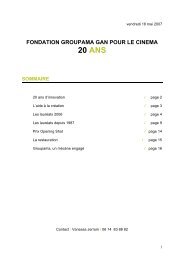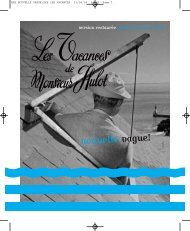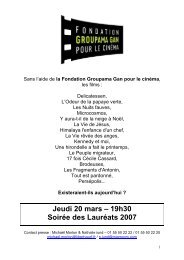Dossier de presse « Lola - Ciné-Tamaris
Dossier de presse « Lola - Ciné-Tamaris
Dossier de presse « Lola - Ciné-Tamaris
Create successful ePaper yourself
Turn your PDF publications into a flip-book with our unique Google optimized e-Paper software.
THE COSTUMES<br />
LOLA’S CORSET<br />
“When we think of <strong>Lola</strong>,<br />
we think of the sublime Anouk Aimée in her music hall singer’s corset.<br />
In this costume, <strong>Lola</strong> poses not as a sad and abandoned young mother,<br />
but as a happy woman who believes in love, in her dreams,<br />
and who proves to us that she is right to do so.<br />
As the ultimate symbol of the ‘frivolous woman’, the corset is nonetheless<br />
referred to by <strong>Lola</strong> as her “un<strong>de</strong>rshirt”, which she lives in,<br />
both in town and on stage. The film was not a musical comedy per se,<br />
but <strong>Lola</strong> lives her life as though it were: she has the costume for it.<br />
Jacques Demy was inspired by American actresses of the post-war period.<br />
He <strong>de</strong>dicated <strong>Lola</strong> to Max Ophüls, who, in Le Plaisir,<br />
brought to life free-spirited women in corsets.<br />
Demy invented <strong>Lola</strong>: a glamorous, moving, funny and timeless woman.<br />
Jacques Demy will always inspire us to live our dreams.<br />
Thank you, Monsieur Demy!”<br />
the RESToRATION<br />
LOLA LIKE NEW<br />
A negative burned in a fire<br />
The original negative of <strong>Lola</strong> from 1960 (Franscope,<br />
black and white, with images by Raoul Coutard) burned<br />
in a fire at the GTC laboratory in around 1970, along<br />
with the optical sound and the internegative.<br />
The film slumbered, while several old prints circulated.<br />
In 1999, Bruna, the widow of Georges <strong>de</strong> Beauregard,<br />
a film producer in 1960, transferred all of the old film<br />
stock and its associated rights to Mathieu Demy. But<br />
there was no negative! Ciné-<strong>Tamaris</strong> was assigned the<br />
task to revert exploitation receipts!<br />
In search of elements<br />
It was first necessary to find an element that would allow<br />
a new internegative to be ma<strong>de</strong>.<br />
Agnès Varda questioned a dozen film institutes. The<br />
goal was to find a release print taken from the original<br />
negative of <strong>Lola</strong>, one that had been printed in the sixties,<br />
before the fire, so that it could be used to produce<br />
a new negative.<br />
A copy that had been <strong>de</strong>livered to the BBC in 1961 was<br />
found at the British Film Institute (BFI). In those days, new<br />
copies of films were given to television stations, printed in<br />
low-contrast, since the televisual effect contrasted the<br />
images. They were not (or rarely) screened afterwards.<br />
This print was therefore in good shape.<br />
A new internegative created in 2000<br />
Based on this copy, it was possible for the Archives<br />
Françaises du Film (CNC) to create a new 35 mm internegative<br />
by contact, in 2000. Agnès Varda and Raoul<br />
Coutard supervised the color grading.<br />
For years, this sound-and-image internegative had<br />
been used to print the copies required for certain rereleases<br />
and master copies for television broadcasts.<br />
These were new copies, of course, but some sequences<br />
were too pale or lacked nuances.<br />
A complete restoration project in 2012<br />
with a team located in Paris and Los Angeles<br />
In 2012, with a view to the Demy exhibition to be held at<br />
the Cinémathèque Française in 2013, a complete restoration<br />
was launched by Ciné-<strong>Tamaris</strong>, the Groupama Gan<br />
Foundation for Cinema and the Technicolor Foundation<br />
for Cinema Heritage, and, also in Los Angeles, by the<br />
Technicolor laboratory, un<strong>de</strong>r the aegis of Tom Burton.<br />
The film was now finally able to benefit from a digital<br />
restoration of its sound and image. This laboratary<br />
has already worked on complex restorations with the two<br />
Foundations, such as Jacques Tati’s Mr. Hulot’s Holiday<br />
and Georges Méliès’ A Trip to the Moon in colour, in 2011.<br />
For <strong>Lola</strong>, the film and digital elements resulting from<br />
this work will permit both the archival conservation of<br />
the 35 mm elements and a wi<strong>de</strong> international distribution<br />
of <strong>Lola</strong> in the form of DCP files, the current projection<br />
standard.<br />
The wi<strong>de</strong>st possible distribution<br />
of the restored work<br />
As with all of the projects led by the two Foundations,<br />
a full release schedule for both France and abroad has<br />
been <strong>de</strong>vised by Ciné <strong>Tamaris</strong> with the right-hol<strong>de</strong>rs,<br />
running parallel to the restoration process.<br />
Primary objective: the big screen<br />
The première screening of <strong>Lola</strong> in its restored version<br />
will thus take place in June 2012 at the Il Cinema<br />
Ritrovato festival in Bologna, followed by the Festival<br />
International du Film <strong>de</strong> La Rochelle, in the presence of<br />
Anouk Aimée and the Demy family. The film will then be<br />
presented at all the major international festivals… in<br />
anticipation of the 2013 Demy Exhibition.<br />
Finally, as part of its consistent aim of reaching<br />
the wi<strong>de</strong>st audience possible, the theatrical release in<br />
France of the DCP files, or 35 mm copies, has been entrusted<br />
to Sophie Dulac Distribution and is scheduled<br />
to commence as of 25 July 2012.<br />
<strong>Lola</strong> can get back on track…<br />
THE PITFALLS OF LOLA: THE STORY OF THE RESTORATION<br />
Fifi Chachnil<br />
Fashion <strong>de</strong>signer<br />
Complete restoration is a complex process with many<br />
implications. It involves a very different approach from<br />
simply remastering a film for a studio that wishes to<br />
release it on Blu-ray and thus bring a product up to<br />
date and adapt it to more recent criteria.<br />
What follows is a brief outline of the various phases<br />
involved for the team working on the project.<br />
Damage to the original elements<br />
The film of the duplicate negative was very damaged<br />
and nee<strong>de</strong>d to be manipulated with care. One of the risks<br />
involved is that by manipulating the elements, unintentional<br />
damage can often be caused: small perforations<br />
may get bigger, an image may be torn and so on.<br />
The work involved in a restoration project is that of<br />
replacing all of these missing images, or, where possible,<br />
restoring the original structure of the action.<br />
We had to find a way of fixing these problems – the<br />
physical damage and the photochemical <strong>de</strong>composition<br />
that had <strong>de</strong>gra<strong>de</strong>d the picture over time. By now, it<br />
had become very contrasted, with a very large grain.<br />
70 I LOLA LOLA I 71
















